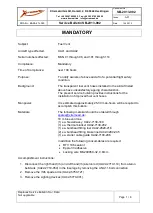
PHYSIOLOGICAL
TRAINING
WHAT IS IT?
Physiological training is a program directed
toward understanding and sur viving in the
flight environment. It covers the problems of
both high and low altitudes and recommends
procedures to prevent or minimize the human
factor errors which occur in flight.
WHO NEEDS IT?
The course is primarily of benef it to pilots.
It is also recommended for other air crew
personnel, air traff ic controllers, aviation
medical examiners and other personnel from
the national aviation system.
WHERE CAN YOU GET IT?
A resident physiological training course at
the FAA’s Aeronautical Center in Oklahoma
City is devoted entirely to problems in civil
aviation (Figure 17-9). Many militar y in-
stallations, and the National Aeronautics
a n d S p a c e A d m i n i s t r a t i o n ( NA S A ) i n
Houston, Texas, conduct a resident program
for non-gover nment personnel.
HOW LONG IS THE COURSE?
The course takes one full day.
WHAT IS CONTAINED IN THE
COURSE?
Many topics are covered. They include the
environment to which the flyer is exposed,
p h y s i o l o g i c a l f u n c t i o n s o f t h e b o d y a t
ground level, and alteration of some of these
functions by changes in the environment.
The higher one flies, the more critical be-
comes the need for supplemental oxygen.
This need is discussed so that the trainee
will understand why a pilot cannot fly safely
at altitudes in excess of 12,500 feet for a
prolonged period without some aid, either
supplemental oxygen or a pressurized air-
craft. Both oxygen equipment and pressur-
i z a t i o n a r e d i s c u s s e d . W h e n h u m a n s a r e
confronted with certain stressful situations,
there is a tendency to breathe too rapidly.
This topic (hyper ventilation) and methods
of control are discussed. Ear pain on descent
and other problems with body gases and pro-
cedures to prevent or minimize gas prob-
lems are explained. Alcohol, tobacco, and
drugs are also discussed as they apply to fly-
ing. Pilot ver tigo is discussed and demon-
strated so that the trainee will understand
why a non-cur rent instr ument pilot should
n ev e r a t t e m p t t o f ly i n c l o u d s a n d o t h e r
we a t h e r s i t u a t i o n s wh e r e v i s i b i l i t y i s r e -
duced. Resident courses include an altitude
chamber flight where the trainees experi-
ence individual symptoms of oxygen def i-
ciency as well as decompression. This flight
will demonstrate that:
1. Proper oxygen equipment and its use
will protect an individual from oxygen
def iciency.
2. An individual can experience and rec-
ognize symptoms that will be the same
as those found in actual flight and there-
fore take the necessary action to prevent
loss of judgment and consciousness.
KING AIR C90GTi/C90GTx
PILOT TRAINING MANUAL
17-8
FOR TRAINING PURPOSES ONLY
17
OXYGEN
SY
STEM
Figure 17-9. FAA Altitude Chamber
Summary of Contents for C90GTi
Page 5: ......
Page 7: ......
Page 9: ......
Page 11: ......
Page 13: ......
Page 45: ......
Page 47: ......
Page 49: ......
Page 87: ......
Page 89: ......
Page 97: ......
Page 99: ......
Page 101: ......
Page 113: ......
Page 115: ......
Page 117: ......
Page 139: ......
Page 141: ......
Page 193: ......
Page 195: ......
Page 203: ......
Page 205: ......
Page 207: ......
Page 215: ......
Page 217: ......
Page 219: ......
Page 241: ......
Page 243: ......
Page 259: ......
Page 261: ......
Page 263: ......
Page 277: ......
Page 279: ......
Page 281: ......
Page 283: ......
Page 285: ......
Page 311: ......
Page 313: ......
Page 315: ......
Page 323: ......
Page 333: ......
Page 437: ......
Page 439: ......
Page 441: ......
Page 443: ......
Page 467: ......
Page 471: ......
Page 483: ......
Page 485: ......
Page 487: ......
Page 491: ......
Page 493: ......
Page 495: ......
Page 515: ......
Page 517: ......
Page 519: ......
Page 521: ......
Page 547: ......
Page 555: ......
Page 557: ......
















































